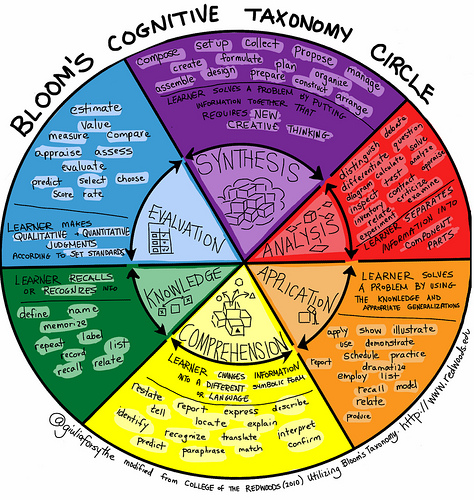Learning Outcomes
The Role of Learning Outcomes
This video discusses the role of learning outcomes in (online, face-to-face, and blended) course design.
Featuring: Natasha Kenny (Guelph), Zopito A. Marini (Brock), Timothy A. Pychyl (Carleton), Samah Sabra (Carleton), Maureen Connolly (Brock), Joy Mighty (Carleton), Steve Joordens (Toronto), Jane Holbrook (Waterloo), Denise Mohan (Guelph).
A learning outcome is a statement that describes what knowledge, skills and values learners should have acquired by the end of a unit of instruction. Outcomes focus on what the students will know, do, or value when they exit the course, program or degree. Note that the focus is on the student rather than the teacher. These are not instructional objectives: they are statements describing the desired abilities of the student with respect to the discipline.
Outcomes include a verb that describe what the student will be required to do to demonstrate that the outcome has been achieved (think about assessment).
For example, by the end of this course, students will be able to …
- Demonstrate, in writing, the ways in which the economy contributed to the rise of WWII.
- Develop verbal communication skills through a classroom presentation on a course topic.
- Identify the terminology related to sexual reproduction.
Learning outcomes should begin with verbs beyond “know” or “understand”. Be specific. What will the student need to demonstrate in order to be successful in the course or in the program? Student success with outcomes should be measurable by the assessments. Clearly identifying the desired learning outcomes and corresponding activities and assessments can help both students and instructors know when and how students will be successful.
For example, if we want our learners to be able to apply knowledge we can design classroom activities and assignments that allow learners to see, hear, and experience the use of knowledge. We might demonstrate how a particular model is applied to a particular problem and then provide students the chance to practice this, and then give students an assignment to demonstrate their understanding. An applied learning outcome might state: students will be compare two websites using the principles of Universal Design.
Bloom’s Taxonomy
This video discusses the relationships between Bloom’s Taxonomy of Educational Objectives, learning outcomes, and the course design process.
Featuring: Anthony Marini (Carleton), Samah Sabra (Carleton), Andrew Barrett (Carleton), Maureen Connolly (Brock), Joy Mighty (Carleton), Natasha Kenny (Guelph), Jane Holbrook (Waterloo), Giulia Forsythe (Brock).
Writing Learning Outcomes
Knowledge. A student is able to name, recall, recognize or label particular terms, content, theories, or principles.
Comprehension. Learners are change information into different forms; they are able to discuss, classify, summarize, explain, generalize or distinguish between elements of knowledge.
Application. At this level, learners are able to problem solve using acquired knowledge; for example they will be able to demonstrate, relate, practice, interpret, manipulate, translate and use knowledge.
Analysis. When we require our learners to understand how the elements of a model work together, organizing principles or the relationships between concepts, systems, or ideas, then our learners will examine, experiment, compare, relate, test, or differentiate knowledge.
Synthesis. When knowledge is synthesized learners will usually create something in a new and novel way or integrate information; they might design, arrange, collage, produce, perform or assemble knowledge.
Evaluation. Learning at an evaluation level usually involves students judging the quality of something; quality might be determined by a set of standards, value, or adequacy. Students, therefore, may estimate, compare, rate, interpret, criticize, conclude, or assess

See also: A Guide to Developing and Assessing Learning Outcomes at the University of Guelph [pdf].

